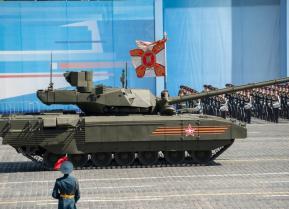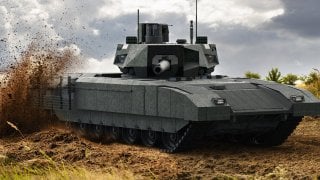Russia's T-14 Armata Tank Might Not Be 'Worth the Trouble'
Russia's T-14 Armata tank, one of the most advanced tanks ever developed, has faced limitations in mass production and affordability, hindering its widespread deployment.
Summary and Key Points: Russia's T-14 Armata tank, one of the most advanced tanks ever developed, has faced limitations in mass production and affordability, hindering its widespread deployment.
-While it boasts impressive features like an unmanned turret, active protection systems (APS), and superior firepower, the T-14 has been kept out of Ukraine's brutal combat due to high costs and the risk of losing such valuable assets. Instead, Russia has relied on cheaper, more numerous Soviet-era tanks like the T-72.
-The T-14's challenges highlight a broader issue modern militaries face: balancing technological advancements with practical affordability and maintenance in prolonged conflicts.
Russia Realizes They Don’t Need the T-14 Armata to Win Wars
Russia outdid itself with the development of its newest Main Battle Tank. The T-14 Armata is one of the most advanced systems ever conceived.
That it was built by a country, like Russia, that so many experts had long ago written off as a dying power is doubly impressive. Sadly for Moscow, however, it turns out that being able to develop one of the most advanced tanks in the world is only half the battle.
A country must be able to mass-produce such technology and maintain these systems in an affordable manner. As it turns out, the T-14 is too expensive to hold in large numbers, and maintaining them is a complex and costly affair – especially in combat conditions.
Their loss in significant numbers would prove to be far more damaging to Russia than if they were never deployed in the first place.
Such is the case for Russia as it wages its conflict against neighboring Ukraine. Indeed, the Ukraine War is predominantly a ground war in which MBTs from both sides factor heavily into the strategic equation. Yet the T-14 has been kept largely out of the thick of the fighting.
The T-14: Worth the Hype?
The T-14 Armata was initially deployed to Ukraine in a cautious manner. These war machines were kept on the periphery of the brutal fighting and never deployed in great numbers.
The handful of times they engaged in combat, Russian war planners quickly pulled them back. What’s more, the tanks that were deployed initially to Ukraine were given additional protections like drone attack shields, indicating how serious of a threat environment for all Russian tanks the Ukraine battlefield has been.
On paper, though, the T-14 Armata is an impressive beast.
For instance, it possesses an unmanned turret with active protection systems (APS). These tanks enjoy enhanced situational awareness, thanks largely to the sophisticated optical gear and sensors that line the vehicle.
Thus, the crew of the tank would have unprecedented situational awareness compared to their rivals. The T-14 was one of the first major weapons platforms created in the modern era by Russia that actually factored into its design enhanced crew protection. Back in the Soviet era, tanks were built with little thought or care afforded to the survivability of tank crews in combat.
Everyone was expendable back then.
NATO has provided lethal anti-tank weapons to Ukraine. Systems like the Javelin have chewed up pretty much all classes of Russian MBTs. They were especially effective at the start of the Russian invasion.
In theory, though, the Armata’s APS could protect against direct anti-tank weapon attacks by launching interceptors to knock out incoming projectiles.
In terms of firepower, the Armata has a 125 mm smoothbore gun that can pop off advanced munitions like guided missiles, giving it above-grade firepower. Further, the T-14 is powered by an engine that gooses the tank up to 1,500 horsepower. The engine is lighter than the one that powers the U.S. Army’s M1 Abrams, the Armata’s chief rival.
Too Expensive for its Own Good
An individual T-14 costs between $5 million and $9 million. That seems like a bargain. But it is not so for the Russians, who have a much smaller defense budget than the United States. Far cheaper and easier to maintain and replace Soviet-era MBTs such as the ubiquitous T-72 (probably the best tank in the world), are doing a fine job for Russia. Moscow doesn’t want to risk its limited number of T-14s in Ukraine.

Russia’s experience with the T-14 mirrors a larger problem that all modern militaries are facing. The quest to stay ahead in capabilities and technology is urgent, but in order to achieve ambitious goals, the systems they are building are increasingly complex and expensive.
At some point, one reaches the law of diminishing returns. The Russians, with the T-14, have likely reached that point, and Moscow is working that realization into their overall battle plans.
It's a smart move.
Author Experience and Expertise: Brandon J. Weichert
Brandon J. Weichert, a National Interest national security analyst, is a former Congressional staffer and geopolitical analyst who is a contributor at The Washington Times, the Asia Times, and The-Pipeline. He is the author of Winning Space: How America Remains a Superpower, Biohacked: China’s Race to Control Life, and The Shadow War: Iran’s Quest for Supremacy. His next book, A Disaster of Our Own Making: How the West Lost Ukraine, is due October 22 from Encounter Books. Weichert can be followed via Twitter @WeTheBrandon.
All images are Creative Commons or Shutterstock.
From the Vault
Russia Freaked Out: Why the U.S. Navy 'Unretired' the Iowa-Class Battleships
Battleship vs. Battlecruiser: Iowa-Class vs. Russia's Kirov-Class (Who Wins?)


